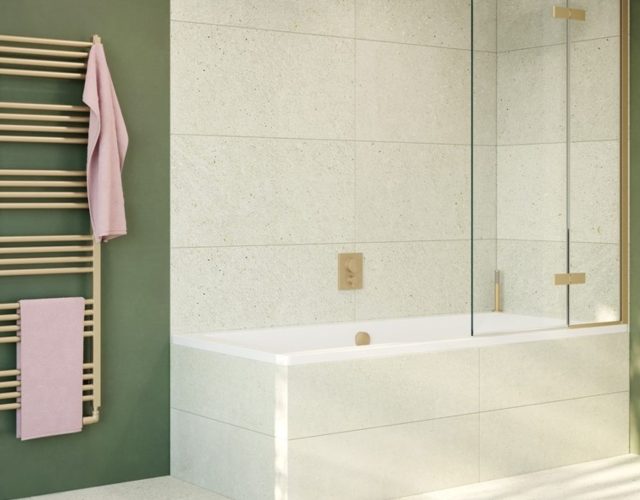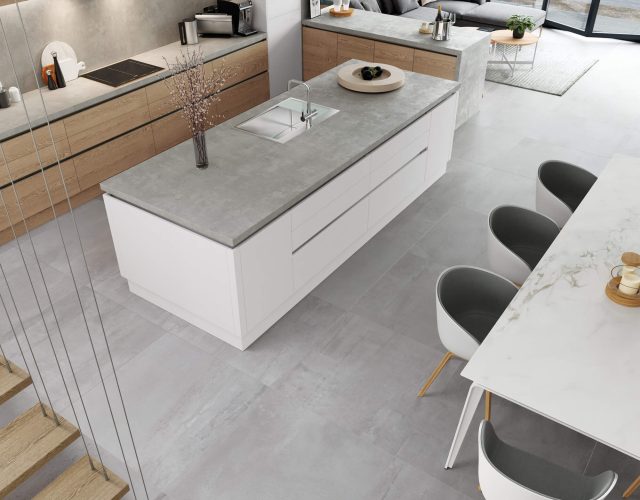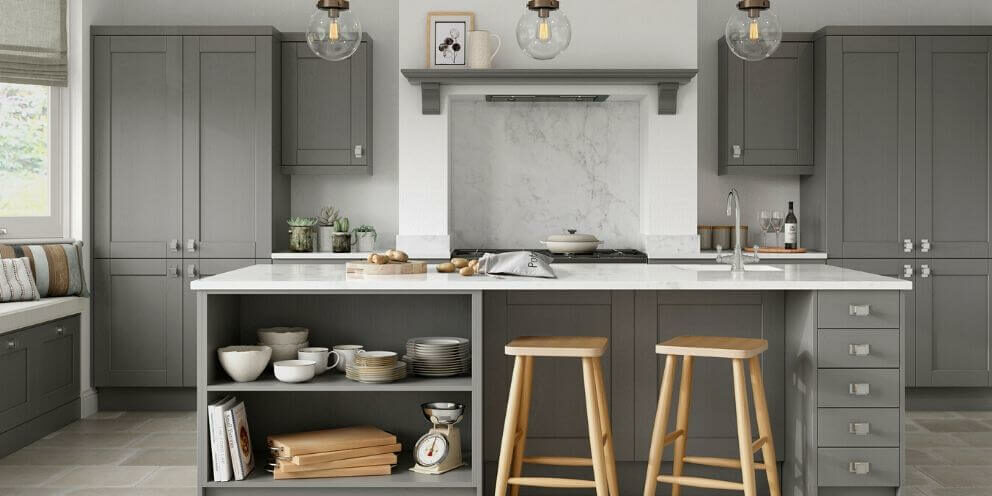

By Lara
How Much Does A Kitchen Cost?
The truth of the matter is there is no simple answer to the question ‘how much does a kitchen cost?’, purely based on the fact that there are so many variables involved that can affect the price range so dramatically. What is instead more useful is a breakdown of the way a kitchen is priced.
A kitchen can, in many ways, be one of the most difficult types of purchases you will ever make. There is no tangible fixed solution that you can pick up off the shelf. You are effectively purchasing a concept long before you ever see the products, colours and styles put together in an end result. And there are so many choices to make and decisions to reach throughout the process before this final vision is realised.
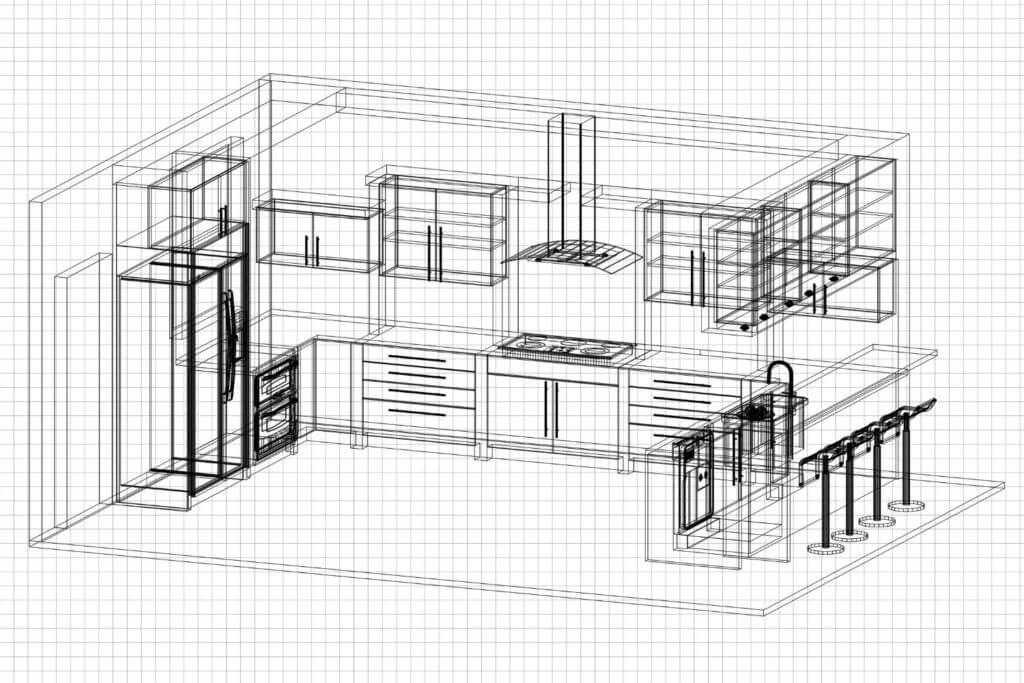
Because of this, there are many people that can feel a sense of dread or trepidation at the thought of buying a new kitchen and so will put the decision on hold. Their worries include things like ‘what if I get it wrong?’, ‘I don’t know where to start’, ‘I have no clue what’s involved’ and, of course, the biggest concern of ‘how much is this kitchen going to cost?’.
How To Start Planning A New Kitchen
To start to look at the cost of a kitchen, it is critical to understand that there are five general areas of cost to factor into a kitchen budget;
- Furniture (cupboards, cupboard doors, handles, legs, hinges and all items needed to build the ‘body’ of your kitchen)
- Worktops
- Appliances (ovens, hobs, fridges etc)
- Installation (the process of fitting your new kitchen into your space)
- Miscellaneous (everything else that you may not have thought of)
Furniture
When people think about buying a kitchen, this is almost always the first area that comes to mind. Both aesthetically and physically, the furniture makes up a good proportion of your kitchen and is worthy of considerable thought.
But, What Do We Mean By Kitchen ‘Furniture’?
The furniture of your kitchen takes in a range of different elements, including the below…
- Cupboards (these are also referred to as units)
- Drawers
- Doors
- Handles
- Legs
- Hinges
- Anything else used to build the ‘body’ of your kitchen
Many kitchen companies will use size examples to give you a better idea of the cost of your new kitchen. For example, an ‘8-12 unit kitchen might cost £xxxx’. Whilst this can give you a figure, the likelihood of that figure being anywhere near accurate is slim, and this could serve to give you a false idea of what the kitchen you really want will cost.
The reason it’s so hard to give you an accurate price is that furniture is made up of different styles, different construction methods and different materials. No unit is the same as the other, and this is why there are so many options and price differences.
How Does The Style Impact The Cost Of My Kitchen?
The style of a kitchen can be one of the main factors that can affect the overall price. This is because some styles need a higher level of detail when it comes to construction than others. The price difference mainly comes down to the door styling (as this makes up 90% of the aesthetic) and what materials are used. As with anything, there are pros and cons to each kitchen style, and deciding on your final style will require some thought.
The main styles of kitchen doors are:
- Slab £
- Shaker ££
- Handleless ££
- True Handleless £££
- In-Frame £££££
What Are The Costs Of Different Kitchen Materials?
Kitchen furniture will vary in price depending on what material it’s made from. Here’s a quick guide to the price of these different materials:
- MDF £ (multi-density fibreboard – you may have seen this used in DIY projects around the home)
- MFC ££ (melamine face chipboard – a mid-range option that is durable and has a long life span)
- Timber/Oak £££ (a premium material with a quality feel)
To make this easier to understand, here’s a good example: Slab doors (one of the cheaper styles of door) can come in MDF or MFC and each will have a different cost. On top of this, whether the door is laminated, wrapped, painted or stained will also affect the cost.
Most kitchen companies will offer these three types of door materials, with the same range of different finishes.
Other Kitchen Furniture To Consider
Pricing your kitchen using an 8 or 12 unit example is similar to asking for the price of your new car with only the chassis, when in reality a whole range of different parts make up a car.
The cost of the units and doors are obvious items to consider in a price. But what about all the other components needed to produce the design? In reality, to get the best out of the room, these types of generic examples do not necessarily help much to acknowledge function, form, aesthetics, practicality and ergonomics as well as getting the most out of your space.
The truth is that there are a whole host of other fixtures and fittings to consider, such as handles, cupboard interiors, opening and closing mechanisms & hinges. Dependent on what options you choose, these too will have a bearing on the price (although a lesser bearing than the units).
The style of the kitchen can have a dramatic impact on the cost. With Shaker, Slab, True Handleless, Inframe and J Trim amongst the options available, the kitchen units can be the hardest to give a ballpark figure to. Discussing these styles with your kitchen designer can best help to define what options may be available to you to best suit your budget.
Typical Furniture Cost £4,000-£20,000
The Price Of Kitchen Worktops
There are many different options available when it comes to selecting a worktop choice, and, like many things in life, there can be benefits and considerations for each material. Some of these choices are set out below;
- Laminate £
- Compact ££
- Mistral ££
- Solid Timber ££
- Granite £££
- Quartz £££
- Corian ££££
- Marble £££££
- Dekton £££££
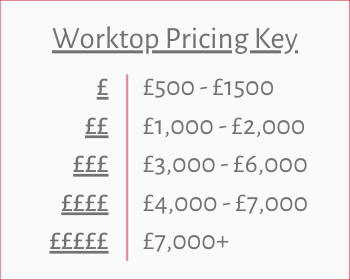
It is important to select the right surface for you, as not only will this surface be one of the most heavily used, but it can also be responsible for a large part of your budget.
Each material will have different ranges available and a different method of installation. Some worktops will need ongoing maintenance, and some will need a specialist fit (which will also impact the cost).
There are broadly two types of worktops in terms of installation type: those that require ‘templating and prefabrication’ and those that do not.
Templating and prefabrication is the process in which a worktop company will attend your home when the kitchen units have been installed, measure the required areas which will have the worktop on, and then produce boards or ‘templates’ of these measurements.
These templates will then be taken back to the worktop factory, and specialist equipment and machinery is used to manufacture these to the required sizes and designs. The worktops are then delivered back to the home and installed onto the kitchen. This can sometimes add weeks of extended time onto the installation schedule of a kitchen to allow for this process to be carried out.
In the case of a worktop that doesn’t need to be templated and prefabricated, lengths of the worktop material will be delivered along with the kitchen units, and these will be measured for, cut and installed in your home at the same time as the units are fitted.
Other worktop features that can impact the cost are:
- Sink type (will your worktop require a special type of cutting?)
- Drainer Grooves (will this be on your sink or in the worktop?)
- Upstands
- Splashbacks
Here’s a helpful infographic to explain the different types of worktop along with their pros and cons…
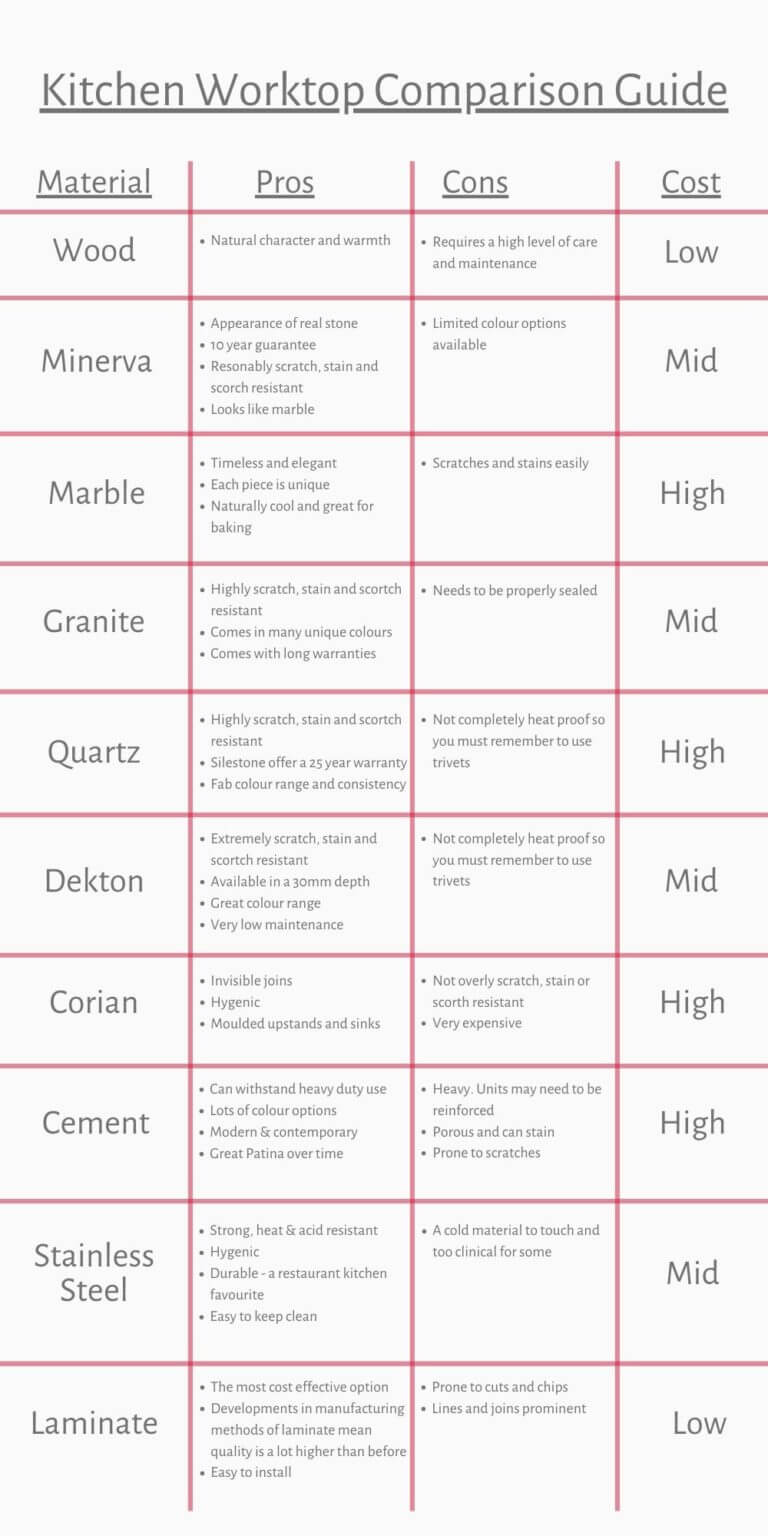
Kitchen Appliances
Kitchen appliances can turn out to be one of the most expensive parts of your kitchen. However, there are some factors that influence this. If you’re not looking to spend a large amount on your appliances (£500 – £2,000) then here are some useful tips to follow:
- Re-use existing appliances
- Purchase freestanding appliances
- Opt for a shorter warranty
- Pick an unbranded appliance
- Purchase second hand
- Look for deals/cashback on your purchases
- Purchase online rather than a kitchen retailer
If your appliances are of the utmost importance to you, then you may wish to invest more in this area (£4,000 – £15,000). The options below will ensure that you get the best from your appliances:
- Purchase new appliances
- Research the features and benefits of each appliance
- Purchase integrated appliances
- Select a trusted brand
- Opt for a longer warranty
- Purchase from your kitchen supplier
When purchasing any appliance, it is recommended to try these out and test them to ensure suitability for your needs.
Making a list of what appliances are needed is important, as these can carry a big chunk of your kitchen cost (unless, of course, you are reusing existing appliances from your current kitchen – if any are being reused, it’s very important to let the person designing your kitchen know so that this can be factored into both the cost and design).
Another reason for this list is that people are often surprised that, when written down, it can end up being longer than they had imagined. Some of the list may include;
- Oven
- Microwave
- Hob
- Extractor
- Fridge
- Freezer
- Dishwasher
- Washing Machine
- Tumble dryer
- Warming Drawer
- Wine cooler
- Waste disposal
- Coffee Machine
Of course, all these appliances are not always needed, but it’s good to consider all of your options as it’s tremendously difficult (nearly impossible) to add in another appliance after your kitchen has been installed!
The cost of appliances can vary enormously, as each person’s requirement for what they want differs. Brand choice plays a huge part, as does the number of appliances you opt for. Making sure you research what is right for you is an important step. Each appliance can vary from as little as £150 to as much as £5,000.
Typical Appliance Cost: £2,000- £10,000
Different ‘Type’ Of Kitchen Installations
First, let’s look at the simple way to establish the ‘type’ of projects you have available to you. There are broadly speaking three types.
- Supply Only
- Dry Fit
- Full installation
Supply Only
This term is often used to indicate the level of service you will be requiring from your kitchen supplier. In the case of ‘supply only’, the company simply gives you the kitchen completely uninstalled to then make your own arrangements in regards to how it may be fitted into your home.
Your level of involvement in how the design is put together may vary- many people undertaking the ‘supply only’ route actively get involved in planning the kitchen themselves, before giving the company a list of how and what they would like.
If you are considering the ‘supply only’ route, yet do not have the skills, knowledge or confidence to participate in the production of a design layout, a kitchen designer should still be able to offer a design service, even if their company are not installing it for you. This solution is typically opted for by those who;
- Want to install it themselves
- Have a relative or friend that can install a kitchen for them
- Have a builder, kitchen fitter or tradesperson that they will pay to install the kitchen for them
- Are budget-conscious
Dry Fit
There are different terms and phrases in the kitchen industry for this type of installation, but it essentially means the installation of the kitchen cupboards themselves into an empty space, often associated with a new build or extension. The majority of kitchen companies will offer a ‘dry fit’ installation service, in which they will either source you a subcontracted kitchen installer or supply an installer that is employed directly by themselves, i.e they are on their permanent payroll.
The main difference here is that the subcontracted installer is being hired and paid by the kitchen company to install your kitchen but is not employed by the company.
The biggest difference between choosing your own subcontractor and having the kitchen company choose a subcontractor for you is that should any complications or issues occur during the installation of the units, the kitchen company should in theory be responsible for rectifying these.
Typical ‘dry fit’ cost- £2,000- £4,000
Full Installation
The third option is a more complete solution. Although not available from every kitchen company, a ‘full’ installation is project-managed from start to finish by the company.
From day one, when the existing kitchen is removed and disposed of, through to the final sign off on the last day, every aspect is covered and managed for you. The journey will incorporate several weeks of coordinating different tradespeople, such as plasterers, electricians, plumbers, tilers, carpenters and builders, but would usually be project managed by the company to create as seamless a transition between coordinating these works as possible.
- This type of project is ideal for those who;
- Do not want involvement with project management
- Are too busy and don’t have the time to source individual tradespeople
- Do not know any tradespeople and are concerned about choosing inferior workmen
- Are worried about scheduling and tying everyone together
- Want to achieve a fluid schedule
- Prefer a company to take responsibility should anything unexpected occur
It is important to remember that the work involved in a ‘full installation’ will still need to be carried out, regardless of whether the company orchestrates it or not. However, the purchaser of the kitchen would be responsible for ensuring these tradespeople are found and scheduled into their project timeline.
The cost involved in a kitchen company running a fully-managed experience will be higher than individually sourced tradespeople, however there can be a higher level of risk involved and the owner takes full responsibility for the project management and scheduling of the workmanship.
Typical ‘full installation’ cost (via a kitchen company): £2,000-£7,000
Other Parts Of Your Kitchen To Think About
This is an often-overlooked area when pricing a kitchen but can make an enormous difference when properly explored. The miscellaneous section would account for all those ‘extras’ which do not fall into the previous four categories discussed. These items would be more critical to someone undertaking a ‘supply only’ or even a ‘dry fit’ style project, as these items would need to be sourced and costed by the individual, whereas in the scenario where a kitchen company is offering a fully inclusive kitchen installation, it is most likely that these extras will have already been factored in to the cost.
Some examples of these items might be;
- Flooring
- Tiles
- Grout
- Trim
- Latex
- Adhesive
- Lighting
- Socket points
- Drivers
- Unit Internals
- Internal Mechanisms
- Plinth seal
- Electrical gadgets
- Splashbacks
- Internal storage solutions
It is important to budget properly for these extras, as the cost of these can quickly snowball and someone could find themselves spending hundreds or even thousands of pounds, unexpectedly.
Obviously, some of the items listed above are trivial, but for others, you will need to apportion some budget. Here’s more information about the larger costs you will incur in the ‘miscellaneous’ category.
How Much Does It Cost To Replace Your Kitchen Floor?
The cost for replacing your new kitchen floor can heavily depend on the size of the room, removal of the old floor, fitting of the new floor, material of the new floor and what underlay options are available to you.
Underfloor heating is a popular option but will also impact the cost of your project as well as limiting you to what flooring you can have.
Within the flooring market there are plenty of options for different needs and budgets:
- Laminate £
- Vinyl £
- Tiles ££
- Karndean £££
- Solid Oak £££
How Will Wall Finishing Affect The Cost Of My Kitchen?
Once your new kitchen has been installed, finishing the walls between the worktop and wall cabinets can really create a statement piece for your kitchen. Whether you pick a statement selection of tiles, a bright kitchen paint or a funky bespoke glass splashback, each can impact the cost dramatically.
Here are some of the options to think about:
- Kitchen paint £
- Matching worktop upstands & kitchen paint ££
- Tiles £££
- Glass splashback behind your hob mixed with any of the above £££
- Glass splashback around the entire kitchen ££££
- Solid Surface (Quartz or Granite) Splashback ££££
Finishing Touches – How Can You Make Your Kitchen Perfect For You?
On top of all the above, there are some other finishing touches to consider which will also impact your price. Here is a small list of the additional features you can add to your kitchen:
- Lighting
- Glass Cabinets
- Internal storage solutions
- Electrical Gadgets (Bluetooth speakers and smart kitchens)
Each of the above can vary considerably on cost. Lighting can be added on a budget with plug-in lighting, or it can be a wow factor to your kitchen and be linked up to your Alexa or Google Home, so you only have to say a word to turn them on!
Typical Miscellaneous Cost: £500-£4000
In Summary
Looking through the budget areas outlined and working out which costs would apply to your project, should offer an estimation of the approximate ballpark budget area you should expect to pay for your kitchen project, as well as what costings and works should be considered when pricing.



